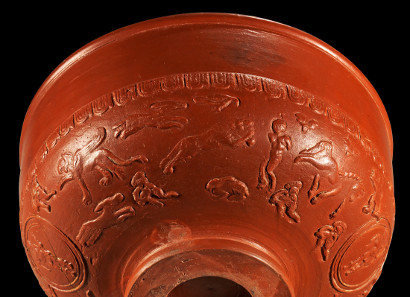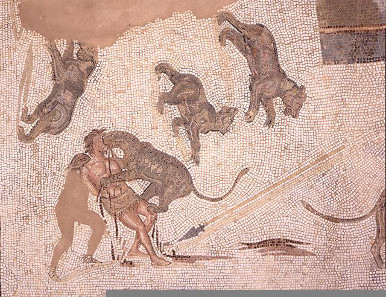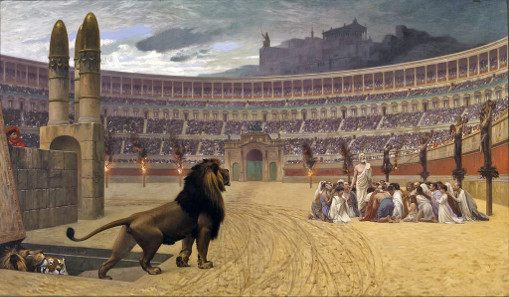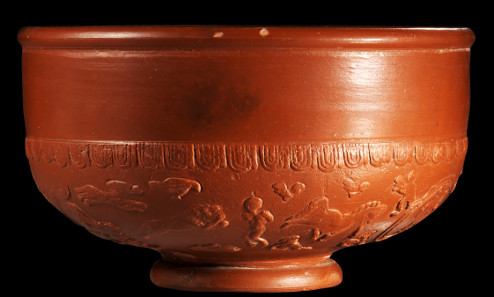As part of Auction 231 comprising “Ancient Art”, Gorny & Mosch presents an object that is a splendid illustration of the history of Roman law. A Terra Sigillata bowl from the 2nd to the 3rd centuries A. D. depicts a damnatio ad bestias. This type of execution was likewise applied to counterfeiters of coins.
Terra Sigillata bowl with damnatio ad bestias. Roman, La Graufesenque, 2nd-3rd cent. A. D. Auction Gorny & Mosch “Ancient Art” 231 (June 17, 2015), lot 60. Estimate: 3,000 euros.
A naked man is standing there, his head lowered, the legs slightly bent, his hands bound at his back. He looks in the jaw of a lion which is jumping at him, about to tear him to pieces. The artist has embedded this depiction, shown in detail on a Roman Terra Sigillata bowl made in the 2nd to the 3rd centuries A. D., in a circus scene with fighting gladiators and wild animals.
Damnatio ad bestias. Third-century AD mosaic in the Museum of El Djem (Tunisia). Source: Wikipedia. Photo: Rached Msadek.
This poignant depiction refers to a type of Roman execution that is called damnatio ad bestias, hence the condemnation to the beasts . This penalty was applied to those who had committed the most serious offences to society: deserters, poisoners, sorcerers and their customers, kidnappers of children, poisoners, leaders of rebellions and – last but not least – counterfeiters of coins, at least in some cases.
This punishment is laid down in the lex Iulia peculatus, a law dating from the times of Caesar or Augustus dealing with the embezzlement of public property. Counterfeiting of coins was classified as such: “If they (the counterfeiters; author’s note) are free, they shall be given to the beasts, if slaves, they shall pay the ultimate penalty.” By the wording alone, the modern reader cannot tell the subtle underlying difference in respect of the punishment. Both terms are describing the death penalty.
And this was the sentence for counterfeiting coins already in the first Roman law that dealt with this kind of offence. If we follow legal texts dating to later times, the lex Cornelia testamentaria nummaria, enacted around 81. B. C., stipulated the following: “Those who counterfeit gold or silver money, adulterate, wash, cast, cut, corrupt or intrude a vice into gold or silver coins, or refuse a money stamped with the face of the emperor unless it is a fake one: if they are of the elite they shall be exiled to an island, if they are of low class they shall be condemned to the mines or the cross. Slaves shall be punished capitally after the deed… Anyone who gilds or silvers base metal, anyone who mixes gold with silver, who plates coins using non-ferrous metal or tin, shall pay the penalty for counterfeiting.”
Again, the type of punishment depends on the status of the criminal. The members of the elite were merely sentenced to deportation while the rest of the free population were sent to working in the mines or were crucified. Working in the mines was no harsher kind of deportation but resulted in death, though not within hours but within months. Slaves were sentenced to death, as in the other text, without the type of death being specified.
Jean-Léon Gérôme (1824-1904): La dernière prière des martyrs chrétiens (The Christian Martyrs’ Last Prayer).
It does not seem highly likely that our bound delinquent in the bowl’s depiction has actually been found guilty of counterfeiting coins. His offence remains open. He might well be a Christian, one of the many that were being executed in the arena. That happened particularly often after Marcus Aurelius had limited the sum allowed to spend on gladiators at public games to 2,000 sestertii in A. D. 177. It was impossible to fund games with such low a sum. This situation further worsened when, as compensation, the philosopher king permitted state officials to sell captives for a symbolic sum of money to the hosts of games. It served as an incentive to sentence as many people as possible to death in order to organize more or less decent games after all. In contrast to kidnappers and counterfeiters of coins who were rather difficult to catch, the Christians were easy to come by, due to the fact that they quite willingly declared themselves guilty of the “crime”. The inconsiderate legislation of Marcus Aurelius therefore led to the great persecution of Christians at Lyons in 177.
Total view on Terra Sigillata bowl with damnatio ad bestias. Roman, La Graufesenque, 2nd-3rd cent. A. D. Auction Gorny & Mosch “Ancient Art” 231 (June 17, 2015), lot 60. Estimate: 3,000 euros.
That would fit our bowl perfectly, both chronologically and geographically. After all, it was produced in Roman Condatomagus, modern La Graufesenque, a village not far from Millau in Southern France. In Roman times, Condatomagus had been known wide and far, and is thus mentioned in the Peutinger Map. Its pottery manufactures were highly important and exported their products to every corner of the Roman world. Our bowl comes from the factory of Lupus, as a workshop’s stamp reveals: Lupus fe(cit) – Lupus made [it].
His creations surely were to the masses’ taste because the execution of convicted criminals – whether counterfeiters of coins or Christians – attracted a thrilled audience to the arena. Taking delight in other people’s misery is by no means a modern invention although we moviegoers can find some comfort in the fact that we see no real blood being shed but mere stage blood.
If you are interested in the object featured in this article, you can go directly to the Gorny & Mosch Auction 231, where they are on offer.
Of course, CoinsWeekly is also offering an auction preview of this sale.







